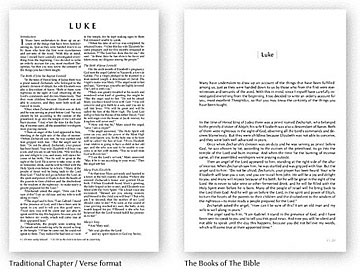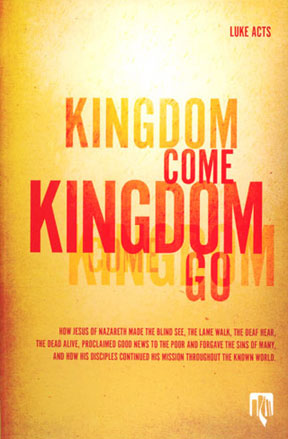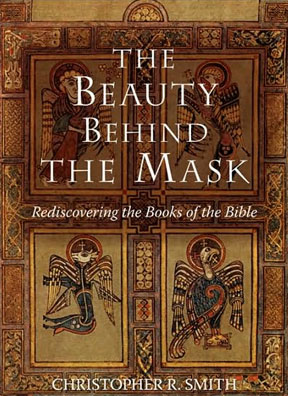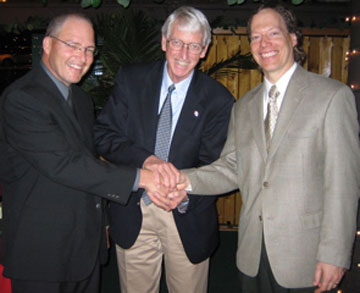|
Interview of Chris Smith; The Books of the Bible; The Beauty Behind the Mask; Christopher R. Smith
Rediscovering the Books and Beauty of the Bible: An Interview with Chris Smith
by Rev. Dr. Mark D. Roberts
Copyright © 2008 by Mark D. Roberts
Note: You may download this resource at no cost, for personal use or for use in a Christian ministry, as long as you are not publishing it for sale. All I ask is that you give credit where credit is due. For all other uses, please contact me at mark@markdroberts.com. Thank you.
Interview of Chris Smith: Part 1
Part 1 of series: Rediscovering the Beauty of the Bible
Permalink for this post / Permalink for this series
If you're a regular reader of my blog, you know how much I value the Bible as God's Word. Thus it won't surprise you to know that I'm troubled by the surveys that show most Americans, even most Christians, don't read the Bible very much. We own Bibles, sometimes many of them. But we don't tend to open them very much.
There are some good reasons for this, apart from obvious spiritual ones like sin. Many of us don't read the Bible because it isn't easy to read. Many translations make the Bible seem like a distant relative who speaks English with a strong accent we don't easily comprehend. Even the layout of the Bible makes it seem more like a rulebook and less like a story we'd actually like to read.
Thus I'm interested in efforts to help today's people actually read and understand the Bible. Eugene Peterson's fantastically successful The Message is the most familiar of such endeavors, but his is not the only one. Chris Seay of Ecclesia, an emergent church in Houston, is heading up a project called The Voice. This is an effort to gather scholars, writers, and poets together and produce an accurate, contemporary translation of the Bible. It's something like The Message for the next generations.
Another effort to help folks get into Scripture comes from The International Bible Society. It's called The Books of the Bible. It's not a new translation of Scripture, but rather a new presentation of the biblical text. One might argue that it's really a renewed version of the original presentation of the biblical books, before editors got to them. One of the major goals of The Books of the Bible is to convey the beauty of the biblical text, especially its narrative.
I learned about The Books of the Bible from an old friend, Chris Smith. He and I got reconnected through the Internet, renewing our college friendship. In the course of our communication, Chris shared with me what he's been doing recently, and much of this focused on The Books of the Bible.
 I thought it would be helpful for my readers to get to know Chris, and especially to learn more about his exciting biblical project. So, beginning today, I'm doing an online interview of Chris. I expect you'll be as fascinated as I was to learn about his Bible project. (Photo: Chris Smith) I thought it would be helpful for my readers to get to know Chris, and especially to learn more about his exciting biblical project. So, beginning today, I'm doing an online interview of Chris. I expect you'll be as fascinated as I was to learn about his Bible project. (Photo: Chris Smith)
Interview of Chris Smith, Part 1
Mark: Hello, Chris. Thanks so much for taking the time to do this interview. We were good friends while at Harvard. Only recently have we made contact through the Internet. So what have you been doing since 1980?
Chris: Yes, I'm afraid it has been that long. I went to Gordon-Conwell Theological Seminary and then did a Ph.D. in the ecumenical, interdisciplinary theological studies program at Boston College and Andover Newton. Before finishing seminary, I took several years off and worked first as a pastor and then as a writer-editor for the Department of Communications in Canada, where my wife Priscilla is from. After finishing my doctorate, I pastored the First Baptist Church of Williamstown, Massachusetts for nine years. Lots of students from Williams College came to the church and it was great to work with them. I've now just completed a six-year pastorate at the University Baptist Church of East Lansing, Michigan, where I once again enjoyed working with undergraduate, graduate and international students at Michigan State University, as well as faculty, staff and administrators.
Mark: So you've been a student, a writer-editor, and a pastor during the last 28 years. How did you end up getting involved in a project to reconfigure the Bible to enhance its readability?
Chris: Over the years I've also been writing and teaching. I've pursued a particular interest I have in the books of the Bible as literary creations. I guess this dates back to my years as an English major at Harvard, and even farther back to my being raised by a father who is a pastor and a mother who is a professor of literature. I've written in academic journals about the literary structures of biblical books, and taught adjunct and extension courses on books of the Bible. In 1999 I offered a course on "The Bible Without Chapters and Verses" at the Regent College Summer School in Vancouver. Through this course, Glenn Paauw, director of product development for the International Bible Society, found out about my work. He asked me to help him and his team with the new Scripture format they wanted to design. I and a couple of others began working with them as consultants in 2003. Today's New International Version (TNIV), for which IBS holds the copyright, was being released in 2005. The goal was to have an edition of the TNIV in the new format ready soon after the original release of the translation. The Books of The Bible was published in the summer of 2007. (Photo: Members of the Bible design group, from left to right: Glenn Paauw, Lisa Anderson, John Dunham, Gene Rubingh, Chris Smith, Paul Berry, Jim Rottenborn. Missing from this picture: John Kohlenberger, Micah Wierenga.

Mark: So why did you want to change the way the Bible is presented? It almost sounds like you're tampering with Scripture. You're not messing around with God's truth, are you?
Chris: Not at all. In fact, our starting point was the belief that the Bible is the inspired word of God and that therefore, when we open our hearts to its message, the Holy Spirit brings us to faith and transforms our lives, relationships, and communities. The problem is, people just aren't reading the Bible. Research has shown that while millions of Bibles are distributed in America every year, relatively few of them are ever read. One of the main reasons for this is the format in which the Bible is presented. People see two columns of tiny type, sprinkled with large and small numbers, crowded between notes and references, and it looks like no book they've ever seen before. It's unattractive, and they don't want to read it.
Mark: As I get older and my vision gets worse, I'm quite aware of that "tiny type" reality. But I'd imagine that the peculiar way in which the Bible is printed can even keep younger readers with great vision from digging in to God's truth. Yes?
Chris: Yes, indeed. The visual presentation of the biblical text discourages people from picking up a Bible in the first place. But even when people do try reading the Bible, they often don't understand or enjoy it.
Mark: Okay, so where did we get those chapter and verse numbers, anyway? I know they weren't in the original biblical manuscripts. When were they added?
Chris: The chapters and verses that the Bible was divided into came many centuries after its books were written. Chapters were introduced around 1200 AD, so that authors of commentaries could refer to passages more easily. Verses were added around 1550 AD, originally so that a concordance to the Greek New Testament could be prepared. In other words, chapters and verses were introduced so that reference works could be created. They were never intended to guide devotional reading or to structure public teaching.
Mark: It seems strange to think of the Bible without the chapters and verse numbers, since they're so much a part of the Bibles we read today. They almost seem sacred, though I know they're not. Why do these get in the way of our understanding of Scripture?
Chris: Chapters were intended to be roughly all the same length. But the natural sections of biblical books are of greatly varying lengths. Thus chapters tend to divide up a longer sections into shorter ones, or else put shorter sections together into what looks deceptively like a coherent unity. For example, in 1 Corinthians, discussions of single topics have been divided into chapters 1, 2, 3 and 4; into chapters 8, 9 and 10; and into chapters 12, 13 and 14. Meanwhile, two shorter discussions have been combined in chapters 6, 7, and 11. Another short discussion is attached to Paul's travel plans and greetings in chapter 16. Only chapters 5 and 15 consist of a single discussion in its entirety. How can anyone understand a book that's been divided up like this, if they try to read it chapter by chapter?
Mark: When I've read devotionally through the Bible, going chapter by chapter, I've experienced what you're talking about. But I've never given this too much thought, honestly. So what's wrong with the verse numbers?
Chris: Adding verses to chapters made things even worse. Verses create the impression that the Bible consists of series of independent statements--that it's a collection of authoritarian rules or doctrinal propositions. This is particularly deadly for a postmodern audience, which is not really receptive to those things. But postmodern people are very receptive to art, music, poetry and the like. If we can make the original literary forms of the biblical books visible once again, postmoderns will be much better able to receive the message the Bible has been trying to convey all along through its stories, songs, letters and poems. All of us, in fact, would do better to engage the Bible as a collection of literary creations that together trace the path of God's redemptive work.
Interview of Chris Smith: Part 2
Part 2 of series: Rediscovering the Beauty of the Bible
Permalink for this post / Permalink for this series
Yesterday I began interviewing Chris Smith, a pastor, scholar, and old friend from college days. Chris has been involved in a fascinating project to restore the original look and feel of the Bible, thus increasing its readability.
When I ended Part 1 of the interview yesterday, Chris was talking about how important it is to engage the Bible as a collection of genuine literary creations.
Mark: I'm tracking with you. So what did you and the others team do to solve these problems?
 Chris: The first change we made to the Bible's format was to remove chapter and verse numbers entirely from the text. We included only a chapter-and-verse range at the bottom of each page. We also removed the TNIV section headings, which the translators explain are included just as an "aid to the reader" and are "not to be regarded as part of the biblical text." We moved the translators' notes, which are an integral part of their work, to the back of each book. We printed the text in a single column. We used white space of varying widths to indicate the literary structures of books, so that readers could follow them visually and inductively. When people see all of this, they say, "This makes the Bible look like a real book!" "It is a real book," I tell them. "Read it, and it will change your life." (Photo: A comparison of the opening of Luke in a traditional format and in The Books of the Bible format.) Chris: The first change we made to the Bible's format was to remove chapter and verse numbers entirely from the text. We included only a chapter-and-verse range at the bottom of each page. We also removed the TNIV section headings, which the translators explain are included just as an "aid to the reader" and are "not to be regarded as part of the biblical text." We moved the translators' notes, which are an integral part of their work, to the back of each book. We printed the text in a single column. We used white space of varying widths to indicate the literary structures of books, so that readers could follow them visually and inductively. When people see all of this, they say, "This makes the Bible look like a real book!" "It is a real book," I tell them. "Read it, and it will change your life." (Photo: A comparison of the opening of Luke in a traditional format and in The Books of the Bible format.)
Mark: This conversation has stirred up some old memories of studying the Bible while I was in college. We used a method recommended by InterVarsity Christian Fellowship. It was called "manuscript study." Basically, we looked at an English translation of some book of the Bible that was very much like the original Greek manuscript of that book, without chapters or verse numbers. Our English manuscripts did have spaces between words and punctuation, however, unlike the original Greek writings. I was glad for that. Anyway, it was fascinating to study the Bible without the familiar crutches of chapters and verses. I learned a lot from those exercises. It sounds like you're doing something similar. You want people to appreciate the books of the Bible in the form they were written, not in the shape they were later given. Was that why you put some books back together?
Chris: Yes. Some of the longer books became divided over time. Samuel-Kings, for instance, is really one long narrative. It describes the reigns of the kings of Israel and Judah from Saul to the exile. A single literary structuring device is used throughout the whole work. At the beginning or end of a reign, a formula appears that tells us how old a king was when he came to the throne, how long he ruled, and from what city. Samuel-Kings is known in the Septuagint, the ancient Greek version of the Old Testament, as the "Book of Reigns," and I think that's a pretty accurate title. It was divided into four parts so that it would fit on scrolls that could be handled conveniently. But these parts are "stitched together" editorially by a scribal convention in certain Septuagint manuscripts. The opening words of "2 Samuel" are copied onto the end of "1 Samuel," to show that the two parts should be attached to one another. The same thing happens between the other parts of the work. So it's really one long book.
Mark: What about the New Testament? Did you combine any of those books?
 Chris: Yes, we did. Luke and Acts, to give another example, are two volumes of a single historical study. Together, they have an overarching "journey to Jerusalem/journey from Jerusalem" outline. We want readers to be able to appreciate these large literary structures that tie together what we are used to thinking of as separate books. In fact, IBS has now published Luke-Acts as a single book, in the new format. (Photo: Kingdom Come, Kingdom Go, one-volume publication of Luke-Acts. Can be ordered here.) Chris: Yes, we did. Luke and Acts, to give another example, are two volumes of a single historical study. Together, they have an overarching "journey to Jerusalem/journey from Jerusalem" outline. We want readers to be able to appreciate these large literary structures that tie together what we are used to thinking of as separate books. In fact, IBS has now published Luke-Acts as a single book, in the new format. (Photo: Kingdom Come, Kingdom Go, one-volume publication of Luke-Acts. Can be ordered here.)
Mark: Why did you change the order of the books?
Chris: We are used to encountering the books of the Bible in a fixed order, but this is actually another later development. Before the advent of the printing press, the biblical books were presented in a great variety of orders, based on different historical, literary and liturgical considerations. The gospels, for example, appear in nine different sequences in the manuscript tradition. Paul's letters are found seventeen different ways.
The order we're familiar with today gives us little help in situating the biblical books in their historical contexts. Paul's letters, for example, are now arranged by length, from longest to shortest. If we numbered them according to a reasonable account of when they were written (scholarly opinions will vary in some cases), with "1" being the first epistle written and so forth, we'd discover that the current arrangement presents them roughly in this order: 6, 3, 4, 5, 8, 10, 7, 1, 2, 11, 13, 12, 9. How can we hope to understand these letters in the context of Paul's life and the development of his thought when we read them in this sequence?
Mark: Maybe people would be able to get into Paul if we put them in the opposite of the biblical order, with the shortest one first. After all, Romans is a pretty tough start for most readers. Philemon would be a whole lot easier. But I can see the value in using a more or less chronological order for Paul's letters. Do you have any more examples of order changes you made?
Chris: Yes. Let's consider the Old Testament prophets. If we read through the prophetic books in the traditional order, we will find ourselves seesawing wildly back and forth between centuries. We should really read Amos, Hosea, Micah and at least the beginning of Isaiah together, since they all speak to the same historical situation in the eighth century B.C. But in the usual order, to get from Hosea to Amos you have to read Joel, which many scholars believe was written several centuries later. And to get from Amos to Micah, you have to read Obadiah, which came 150 years later, and Jonah, which could also be another late book. I think people often give up trying to situate these books in their historical contexts and end up seeing the Bible as a collection of airy precepts removed from human experience and the flow of redemptive history.
Mark: Oh my. When I was young, I spent a lot of time memorizing the books of the Bible in order. Now I'm learning that order wasn't terribly helpful.
Chris: Sorry, but that's true. The traditional order can also confuse us about the literary genre of certain biblical writings.
Interview of Chris Smith: Part 3
Part 3 of series: Rediscovering the Beauty of the Bible
Permalink for this post / Permalink for this series
Today is the third part of my interview with Chris Smith. We're focusing on his recent project, The Books of the Bible, an exciting new way to help folks get into the biblical text and story.
Mark: Chris, when we left off yesterday, you were saying that the traditional order of the biblical books can confuse us about the literary genre of certain biblical writings. Would you give us an example of what you mean?
Chris: Sure. The book of James actually has strong affinities to wisdom collections such as Proverbs and Ecclesiastes. But its placement at the head of a group of "general epistles" encourages us to read it as a letter instead. We will be disappointed and confused if we expect James to develop systematically like an epistle.
Mark: Maybe that's why Martin Luther didn't like James! Anyway, you didn't do what Luther once recommended, did you, and take away James or some other books from the Bible?
Chris: No. All the books are there, I promise. The Books of The Bible presents all of the biblical books in a new order that we believe is better attuned to their historical and literary character. The First Testament has three main groups: the "Covenant History" (the continuous historical narrative that runs from Genesis through Kings); the Prophets, major and minor together, in their likely historical order; and the Writings, grouped by genre: poetry, wisdom, history and apocalypse. In the New Testament we have created four groups, each containing a gospel followed by related works. The gospel and letters of John, for example, are grouped together. Luke-Acts is paired with Paul's letters, since Paul and Luke were co-workers in the Gentile mission. As we write in our preface, through such groupings we hope to "express the ancient concept of the fourfold gospel in a fresh way."
Mark: Fascinating. I've sometimes thought it would be interesting to create a version of the New Testament that put the books in the order in which they were written chronologically. Most folks would be surprised to find the letters of Paul at the very beginning, with the gospels later (though Mark may have been written while Paul was still composing his letters). Anyway, enough of my wild ideas. How have people been responding to this very different way of presenting the Scriptures?
Chris: Really enthusiastically. Even when we circulated a preview edition of the format as it was being developed, people began to tell us what a difference it made. One person explained, "I have been a reader of the Bible for all my life. But after reading just a few pages (literally), I was amazed at what I had been missing all of these years." Since The Books of The Bible was published last summer, we've been getting lots more feedback like this.
Mark: Have you had responses from any bloggers? We bloggers can be a mean, critical bunch, you know?
Chris: In fact people have been out there blogging about their experiences with The Books of The Bible. One guy has given himself the goal of reading through the Bible in a year, and he reports that he's way ahead of schedule. As he was going through the Pentateuch he wrote, "I’m surprised when I finish a book! Normally chapter numbers chart my progress for me whether I want them to or not. And, let’s admit it, many of us find ourselves wondering how much longer Leviticus is going to last. With The Books of the Bible, I reached the end without ever thinking that." We're delighted to hear that people are reading the Scriptures so eagerly.
Mark: Well, if you can get me to read through Leviticus without wishing for the end, that's quite an accomplishment. So where can people get more information about The Books of The Bible, and how can they get a copy?
 Chris: There's an informational web site and blog at www.thebooksofthebible.info. There's a Facebook group called De-versify. I've also written a companion volume to the new edition entitled The Beauty Behind the Mask: Rediscovering the Books of the Bible. It goes into much more detail about everything we've been talking about here. (Photo: The Beauty Behind the Mask by Christopher R. Smith.) Chris: There's an informational web site and blog at www.thebooksofthebible.info. There's a Facebook group called De-versify. I've also written a companion volume to the new edition entitled The Beauty Behind the Mask: Rediscovering the Books of the Bible. It goes into much more detail about everything we've been talking about here. (Photo: The Beauty Behind the Mask by Christopher R. Smith.)
The Books of The Bible can be ordered for $8.99 plus shipping from the International Bible Society at (800) 524-1588 or http://www.ibsdirect.com/c-100-tbotb-the-books-of-the-bible.aspx. Unfortunately it's not available right now in bookstores. (IBS is a non-profit organization that supplies churches and other ministries, and distributes to the public only by direct order.) However, the New Testament can be ordered on amazon.com for the Kindle reader, in four installments priced at 99¢ each. And commercial publishers may produce editions of the Scriptures in this format for sale in bookstores at some point in the future.
Mark: Hah! I've been waiting for a good reason to get a Kindle! Now I've got one. So if I could only come up with an extra $359, I'd be all set.
Interview of Chris Smith: Part 4
Part 4 of series: Rediscovering the Beauty of the Bible
Permalink for this post / Permalink for this series
This is the final part of my interview of Chris Smith, a pastor, scholar, and old friend from college. We've been talking about a fantastic project, The Books of the Bible. The last part of this interview is more personal. As you read about Chris's search for God's direction, you might find some encouragement for your own life.
Mark: Chris, let's conclude on a more personal note. You've told me that you read my recent series on "discerning God's call to ministry," and that you recognized in your own story some of the "seeds" I discussed. Please tell us what those seeds are, particularly as they relate to your participation in the Bible Design Project.
Chris: Well, I recognize most of them, actually. But let me concentrate on the ones like sovereignty, surprise, blessing, and redemption that speak of how we see God stepping into our lives to make connections, open doors, and arrange circumstances that allow us to fulfill the calling He has given us. I think I truly was trying to use the gifts and pursue the interests God had given me. That would relate to "seeds" like stewardship, obedience and whole-heartedness. But for me the really exciting part is when we see how God has been at work and it becomes apparent that we're not just trying to do things on our own.
Mark: Yes, that is exciting. And scary sometimes, too. It takes lots of trust in God and his sovereignty.
Chris: Indeed. I certainly see God's sovereignty in my family background, which I mentioned earlier. If God's plan was for me one day to help reformat the Bible along literary lines, it's hard to think of a better set of parents than a pastor and a literature professor. As someone said to me recently, "You've got the DNA for this."
I also see God's sovereignty in a combination of experiences I had in college. In my courses, we were studying the concept of the "shaping principle" of a work of literature. The idea was to try to identify what overriding goal had determined an author's choices in genre, plot, themes, characterization, etc. At the same time, I was introduced to the method of manuscript Bible study that you mentioned earlier. This helped me recognize that the Bible wasn't a compendium of short devotional passages or pithy sayings, as chapters and verses suggest it is. It was a collection of great literary works, and I could appreciate, investigate and experience them as such, looking for their "shaping principles," just as I did for other writings.
Mark: It's funny how such a relatively simple change in the biblical text, such as taking away familiar chapters and verse numbers, makes such a large difference. And, of course, you're not tampering with the actual text of Scripture, only with the things that human editors have added to God's inspired Word.
So, any other ways you have sensed God's sovereignty in your life?
 Chris: I can also see God's sovereignty at other significant places along the way. When I taught my course on "The Bible Without Chapters and Verses" at Regent College, the students and summer school administrators encouraged me to write up the material as a book. I did, but for various reasons, I wasn't able to find a publisher. My wife and I finally said to each other, "Well, God has our address, and if He wants to make use of this, He knows where to find us." So I posted the book on the Internet. I told various friends that it was out there. Only a few days later, I heard back from a friend who had been in a Sunday School class where Glenn Paauw was the guest teacher. Based on what Glenn was saying, this friend recognized he would be interested in my work. He got Glenn to read the book online, and Glenn then asked me to join the Bible Design Group. The disappointment of not finding a publisher was redeemed by the surprise of being connected with a group that had already developed a vision for the kind of format changes I was advocating, and which had the resources to make a new format a reality. (And my book finally was published as The Beauty Behind the Mask.) (Photo: from left: Glenn Paauw, Jim Oraker, who introduced Glenn to Chris Smith, on right) Chris: I can also see God's sovereignty at other significant places along the way. When I taught my course on "The Bible Without Chapters and Verses" at Regent College, the students and summer school administrators encouraged me to write up the material as a book. I did, but for various reasons, I wasn't able to find a publisher. My wife and I finally said to each other, "Well, God has our address, and if He wants to make use of this, He knows where to find us." So I posted the book on the Internet. I told various friends that it was out there. Only a few days later, I heard back from a friend who had been in a Sunday School class where Glenn Paauw was the guest teacher. Based on what Glenn was saying, this friend recognized he would be interested in my work. He got Glenn to read the book online, and Glenn then asked me to join the Bible Design Group. The disappointment of not finding a publisher was redeemed by the surprise of being connected with a group that had already developed a vision for the kind of format changes I was advocating, and which had the resources to make a new format a reality. (And my book finally was published as The Beauty Behind the Mask.) (Photo: from left: Glenn Paauw, Jim Oraker, who introduced Glenn to Chris Smith, on right)
Mark: That is a great story. God's "coincidences" are amazing sometimes, aren't they? So where are you in your journey of discipleship right now?
Chris: Right now I'm waiting for the next "surprise" God has for me. I felt last summer that the time was coming for me to move on from University Baptist Church because I've been more and more attracted to postdenominational expressions of American Christianity. There are lots of energetic and forward-looking things happening in the denominations today, but I also see some new forms emerging that I'd like to explore and help develop. I fully expected that by the time I finished my ministry at University Baptist this spring, I would know what my next long-term kingdom assignment was going to be. But I still don't. This, in itself, is something of a surprise. But as you wrote in your series on discerning God's call to ministry, we need to "submit to God again and again." When the assignment is to wait patiently and trustingly, we have to accept that, and believe that the sovereign God is still at work in us "to will and to do to His good pleasure." In the meantime, I'm having the opportunity to do some writing and consulting, which I'm really enjoying. Whatever my next longer-term assignment turns out to be, my goal will be to continue helping people experience the life-changing message of God's word, in a form that allows its literary beauties and theological truths to shine through more clearly.
Mark: Your situation reminds me of that of Buddy Owens, a dear friend who once worked for Marantha! Music. He and I worked closely on a Bible project, actually, The NIV Worship Bible. Anyway, Buddy sensed that it was time for him to leave Maranatha!, but he wasn't sure what God had in store for him. For several months he walked with faith but not sight, trusting God for the next step. Finally, God opened an amazing door for Buddy, giving him a major leadership position in Purpose-Driven Ministries, at just the time when everything there was about to explode because of the publication of The Purpose-Driven Life. I was thrilled to see what God did in Buddy's life, and through him in the kingdom of God.
Chris, I have no doubt that God has incredible things in store for you. I'll be praying about this, to be sure. I expect some of my readers will join me.
In the meanwhile, thanks for doing this fascinating interview. I've enjoyed hearing about your project, and will be sure to recommend The Books of the Bible and The Beauty Behind the Mask.
Thanks so much, Chris, for doing this interview!
|

